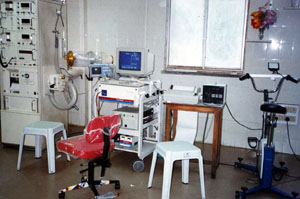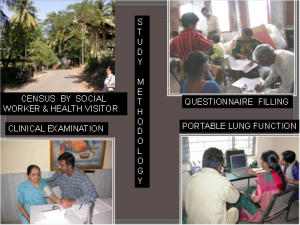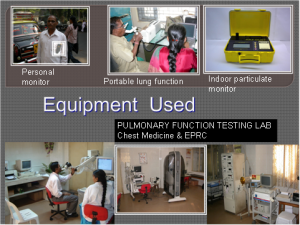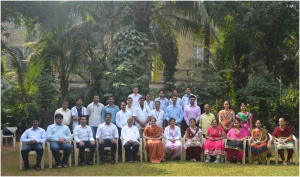Chest Medicine
Background History
Department of Chest Medicine and Environmental Pollution Research Centre ( E.P.R.C )

Department of Chest Medicine and E.P.R.C
The Department of Chest Medicine offers diagnostic facilities & treatment services for pulmonary disorders. Environmental Pollution Research Centre (EPRC : respiratory morbidity health survey unit) has a unique community outreach service to detect impact of environmental factors on lung health. The Department has a 5-bedded Intensive Care Unit with 3 step down beds, with a total of 30-bedded indoor facility. Diagnostic & treatment services are offered to patients with various lung diseases like Bronchial Asthma, COPD, Interstitial Lung Diseases, occupational lung disorders, lung cancer, Tuberculosis, Pneumonias , sleep disordered breathing and acute and chronic respiratory failure .
The department also provides various diagnostic facilities like Lung Functions, Diffusion studies arterial blood gas study, diagnostic & therapeutic Bronchoscopies, Sleep studies and Skin prick and ELISA based tests for diagnosing allergies.
DOTS PLUS Services (unit at GTB Hospital) & RNTCP OPD at KEM under Revised National TB Control programme is looked after by this department. The EPRC team has been actively involved in various community outreach activities like asthma education, health surveys & assessment of respiratory morbidity due to air pollution.
UG teaching: 180 MBBS students
POST GRADUATE: 4 MD (Pulmonary Medicine) students every year.
Staff
Faculty
Teaching:
| Name | Designation | Qualification | Contact info | Teaching experience | Activities/ interests |
Photograph |
| Dr. Amita U. Athavale | Professor & Head | MD (TB and Chest) | Room no.17,
ground floor , CVTC buiding, KEMH , amitaathavale@ rediffmail.com |
23 years | Environmental Pollution related clinical research, asthma, COPD, ILD, lung cancer |  |
| Dr, Vijay S. Khatri | Associate Professor | MD (TB and Chest) | Room no.19,
ground floor , CVTC buiding, KEMH , |
20 years | Tuberculosis, PFT, Asthma, ILD. |  |
| Dr.Sonal Karpe | Assistant Prof. | MD (Pulmonary Medicine) | Room no.19,
ground floor , CVTC buiding, KEMH , sonalkarpe@ yahoo.co.in |
2 years | Critical care, Interventional pulmonology, COPD. |  |
| Dr. Mahesh Jansari | Assistant Prof. | MD (Pulmonary Medicine) | Room no.19,
ground floor , CVTC buiding, KEMH xangpongmak@ gmail.com |
1 year | Critical care, Interventional pulmonology, COPD, Asthma |  |
Non teaching:
| Name | Designation |
| Mr.Harish Kanparia | Head Clerk |
| Mr.Prashant Akotkar | Clerk |
| Dr. Laxmi Menon | Senior Scientific Officer |
| Dr. Sadhna Sakalkar | Junior Scientific Officer |
| Mrs. Rajni Pawar | Junior Scientific Officer |
| Mrs. Hansa Vora | Senior Technician |
| Mrs. Mahananda Wydande | Senior Technician |
| Mr. Manohar Pawar | Technician |
| Mrs. Leena Shardul | Technician |
| Mr. Pramod Lad | Technician |
| Mr. Umesh Karbhari | Technician |
| Mr.Husnuddin Sheikh | Technician |
| Mr.Ramdev Yadav | |
| Mr. Omvir Parcha | |
| Mr. Umesh | |
| Mr. Deepak |
Speciality Medical Officers
| Name | Designation |
| Dr.Hariharan Iyer | Speciality Medical Officer |
| Dr.Prakash Salve | Speciality Medical Officer |
Residents:
| Name | Year |
| Dr.Manjit Tendolkar | 3rd year |
| Dr.Rahul Kendre | 3rd year |
| Dr.Anurag Deshpande | 3rd year |
| Dr.Rajwardhan Ghatge | 3nd year |
| Dr.Aditi Punwani | 2nd year |
| Dr. Bhavya Baldwa | 2nd year |
| Dr.Owais Tisekar | 2nd year |
| Dr.Srikant Shelkikar | 2nd year |
| Dr.Mihir Gangakhedkar | 1st year |
| Dr.Prabodh Garg | 1st year |
| Dr.Reshma | 1st year |
| Dr.Amol Shembatwad | 1st year |
Teaching Activities
Undergraduate studies (U.G.) :
U.G. students are rotated in the department (dept.) for a period of 2 weeks. A well formulated teaching programme imparts them with a basic approach to respiratory diseases
Post graduate Teaching (P.G.) :
Our department has a 3 year residency programme for M.D. (Pulmonary Medicine). Enrollment for this is done immediately after basic medial degree of ‘M.B.B.S.’. We have 6 month posts (2) for unregistered residents and one for E.P.R.C. Registrar. These three posts are short term posts of 6 months duration, mainly benefiting those who wish to gain hands on experience in our unit.
We have a well structured teaching programme for P.G. students in form of weekly case presentation, seminars, Journal clubs, & post OPD case discussions & monthly pathology and radiology meetings, apart from teaching clinical rounds by teaching faculty.
For Student
Student information:
- Post graduate teaching activity every Wednesday and Friday (2:00 to 4:00 pm)
- Chest Radiology meet every alternate Wednesday
- Journal club once a month
- M. Sc. Nursing students from SNDT University and other hospitals regularly undertake Chest Medicine rotation. Besides delivering lectures on important respiratory diseases, bedside clinics, the faculty also acts as “external guide”.
- MBBS, Occupational and Physiotherapy students are regularly posted in Chest Medicine as part of their curriculum and undergo training through lectures and bedside clinics.
- M.Sc Pharmaceutical medicine students are posted for carrying out clinical research in collaboration with our department.
- M.Sc Environmental Science & Biotechnology students have undertaken dissertations based on EPRC data.
For Patient
Out Patient and Indoor Patient Facilities
Out Patient Department (OPD) :
OPD: The Department of Chest Medicine has outpatients Chest clinics on bi weekly basis. (Monday and Thursday: 7:30 to 10:30 pm)
Indoor Patients :
IPD: The Department has a 5-bedded Intensive Care Unit with 3 step down beds, with a total of 30-bedded indoor facility.
Facilities, Equipments and Special Services:
PULMONARY FUNCTION LABORATORY:
State of Art Pulmonary Function Laboratory with Facilities for :
- Spirometry
- Diffusion studies, assessment of residual volume by Helium dilution method.
- Residual volume measurement, airway resistance & compliance measurement by Body Plethysmography.
- Cardiopulmonary exercise testing.
- Rhinomanometry
- Bronchoprovocation test.
- Maximal Expiratory and Inspiratory Pressures
- Portable spirometry
Equipments: MS PFT (Jaeger), Transfer Test (PK Morgan), Body Plethysmograph (PK Morgan), Spiroair (Medisoft/ PK Morgan), Portable Spirometer (Maestroes)
ARTERIAL BLOOD GAS LABORATORY : Arterial Blood Gas analysis laboratory with 2 blood gas analysers and Co oximetry.
Equipments: Cobas b 221, Cobas b 121 (Roche)
SLEEP LABORATORY: Detailed level I polysomnography is done to evaluate patients with sleep disorders.
Equipment: compumedics.
BRONCHOSCOPY SUITE: We provide bronchoscopic services on Wednesday and Friday morning. We also perform Broncho-Alveolar Lavage, which are analysed by trained Pathologist in Cardiovascular Thoracic pathology department.
Equipments : Olympus Video Bronchoscope, Pentax bronchoscope
SKIN PRICK TETS: for allergy
Asthma Education
The department of chest medicine has an asthma education programme for indoor and outdoor patients.
The EPRC team is also involved in creating asthma awareness and health education of school children.
The EPRC team carries out an annual respiratory morbidity survey of BMC employees working in the chlorination department and sewage pumping stations. The environment pollution research centre conducts regular respiratory morbidity surveys in response to citizens complaints regarding air pollution related health issues.
The report of these surveys are sent for publication in the Environmental Status Report.
Special facilities for patients
- An integrated approach to the lung health of the patients rather than only their disease is what we believe in. On the first visit itself the patient is assessed by the physician, the physiotherapist, the dietician and the social worker when applicable.
- As most of the respiratory diseases are chronic conditions, educating the people about the disease, compliance with medications and appropriate usage of drug delivery devices are of utmost importance. Health education is imparted regarding control of triggers and appropriate use of medications.
- Environment plays an important aspect in respiratory cases, so the work and home environment of the patients needs to be assessed in indicated cases. In special cases, a team comprising of a doctor, a social worker and a health visitor visits the patients’ home/work environment to assess any environmental aspect acting as a trigger factor for respiratory ailments.
Studies done at Environmental Pollution Research Centre, Seth G.S.Medical College & K.E.M.Hospital (Reported and published in Environmental Status Report by Municipal Corporation from the year 2002- to 2014.)
- Antop Hill Health Survey – April 2001.
- Health Survey at Prathmesh Complex, Andheri (Stone crushing and quarry units) – Sept. 2001.
- Health Survey at Municipal Printing Press, Byculla – October 2001.
- Respiratory morbidity Health survey of workers at Waste Water Treatment Plant & Chlorination
Plant namely at Colaba, Love Grove, Bhandup complex and Pise Panjrapol. - Tata Mill compound : Star Masala Mill Related health morbidity survey. Year 2002-2003.
- Sutar Chawl Residents – Health Survey – Respiratory morbidity due to gold workers.
- Traffic Police Health morbidity study (Worli Naka, Pydhuni, Matunga, Tardeo & Dharavi) –
May 2002. Traffic Police pollutant exposure to vehicular pollution at heavy traffic junction Vs. Moderate & low traffic areas. - Chembur – Maravali Village 2002-03, Residents health study (Total subjects 728) (Based on air quality results Maravali has high levels of suspended particulates).
- Study conducted to study effects of Biomass fuel on health of women in collaboration with Indian Women Scientists Association
Study Population :
1) Maveshi Village, Bhandardara, Taluka Akola, Dist. Ahmednagar
2) Eksar Village, Karjat.
- Asthma Education & Respiratory morbidity survey at Kumbharli Village, Dombivali – February 2002.
2003-2004
- Project funded by MOEF/WHO National Environmental Health Profile 6 areas in Mumbai City.
(Worli, Bhandup, Khar (W), Andheri (W), Maravali, Borivali (control area)
2004-2005
- Bhuleshwar area (C-Ward) – Respiratory morbidity study in a residential area
- Study of Respiratory health in traffic policemen exposed to vehicular pollution.
- Gorai Dumping ground residential area – Respiratory health morbidity study (site near solid Waste dumping ground facility).
2005-2006
- New Era fabric Mill area health morbidity study.
- Reserve Bank of India employees – To study effects of different modes of transport on Respiratory health.
2006-2007
- Asthma Prevalence study in 8th and 9th std. School children.
- Incidence of silicosis in flour mill workers.
2007-2008
- Bhakti Park, Wadala – Respiratory morbidity related to cement plants around residential Complex.
- Asthma Prevalence study.
2008-2009
- Respiratory morbidity amongst college students (Smokers Vs Non smokers – HP College.
- Shantinagar Colony (slum residents) – Study of health effects near Deonar Dumping ground(Nov. 2008).
- Sudha Park (Chembur) – Health morbidity study (Feb. 2009)
- Mumbai Police Health Survey (Nov-Dec. 2008).
2009-2010
- Problems reported by Residents of Chheda Nagar around Deonar Dumping Ground
- Health effects due to ongoing construction work and cement plan in Kurla area
- Asthma Prevalence study in 8th & 9th std. School Children continued
2010-2011
- Asthma Prevalence in 8th & 9th Std. School children – completed.
- Allergen Testing with ELISA amongst allergic rhinitis and asthma patients to identify trigger factors.
2011-2012
- Zarina Park (Mankhurd) area health morbidity survey (cancer prevalence).
- Asalpha Village, Ghatkopar – Air Pollution related respiratory morbidity.
- Shivdi Police Line & Koli Samaj Shivadi – Exposure to coal dust & traffic related morbidity.
- Gautam Nagar – Deonar BMC Colony, Deonar (control area) respiratory morbidity.
- Initiated project funded by NEERI to study environmental factors responsible for asthma in Mumbai city.
- Longitudinal study of Health Morbidity in subjects exposed to :
Waste water treatment plant (MCGM)
Chlorination plant workers (MCGM)
Areas studied : Love grove (Worli)/Colaba Pumping stations – waste water exposure
related health effects on workers.
Chlorination plant workers – Pise Panjrapol & Bhandup.
2012-2013
- NEERI Project : Study of determining prevalence of Asthma and environmental factors
2013-2014
- Chereshwar CHS Mahul- Air Pollution related respiratory morbidity
- Yewai Chemical Plant
- Ambapada Gavthan, Vishnu Nagar, Anik Gaon, Shankar Deul and Gavanpada, Chembur
- Bhandup Chlorination Plant
2014-2015
- Uttam Society, Chereshwar society (Mahul) Chembur.
- Chlorination plant workers PisePanjra-pol
- Versova Sewage Treatment plant
- F-South Solid Waste Management workers
RESEARCH PUBLICATIONS & ARTICLES IN SCIENTIFIC JOURNALS:
- Research Analysis Report – A Clinical trial of efficacy and safety of Montelukast as Monotherapy in patients with chronic stable bronchial asthma. Athavale, G.A.D’souza, Awasthy, N.P.Singh et al. JIMA, 102; Feb.2004. Pg.109-211.
- Beta(2)-adrenergic receptor polymorphisms and response to salbutamol among Indian asthmatics. Pharmacogenomics 2005 June ;6(4);399-410 16004558. Ritushree Kukreti, Pallav Bhatnagar, Chandrika B.Rao, Simone Gupta, Babita Madan, Chinmoyee Das, Randeep Guleria, Amita Umesh Athavale, Samir Kumar Brahmachari, Balaram Ghosh.
- Once daily ciclesonide delivered via pMDI is effective and safe for the treatment of mild-to-moderate persistent asthma. V.Singh, S.S.Salvi, B.B.Brashier, A.U.Athavale, V.B.Murali Mohan, P.S.Bhttacharya, P.M.Gokhale, P.A.Mahadik, J.A.Gogtay (Jaipur, Pune, Mumbai, Banglore, Mumbai Central, India). Eur.Respir.J. 2006; 28: suppl. 50, 208s.
- Bronchoscopy in Pulmonary Hydatidosis Retrospective Analysis, Journal of Bronchology & Interventional Pulmonology [Vol:16,No.:3, July 2009, Pg:172-175] Association of sleep disordered breathing with systemic hypertension. The Indian Perspective, The Indian Journal of Sleep Medicine[Vol:3,Issue:4, 2008]
- Incremental yield in sputum smear positivity by examining a second early morning sputum specimen in follow up patients on DOTS:7 year analysis of RNTCP laboratory Register, Indian Journal of Tuberculosis[Vol:5,No.:2, April 2011,Pg:60-65]
- Incidence of silicosis in flourmill workers, Indian Journal of Occupational & Environmental Medicine [Vol: 15, Issue: 3, December 2011, Pg: 104-108}]
- Mycobacterium tuberculosis triggers Autoimmunity.Dr.A.U.Athavale Ind.J.Tuberculosis01/2012:59(1)49-51
- Serial Lobar Lung Lavage in Pulmonary Alveolar Proteinosis. Baldi MM, Nair J, Athavale A, Gavali V,Sarkar M, Divate S, Shah U. J Bronchology Interv Pulmonol.2013; 20(4); 333-7
- Specimen collection from chest tubes: A novel method. Milind Baldi, Varun Giri, Jairaj Nair, Amita Athavale. Lung India 2013; 111:272-4
- Disseminated Cryptococcossis with Caverno-Oesophageal Fistula in a Case of Idiopathic CD4+ T-Lymphocytopenia. Jairaj P. Nair, Amita U Athavale, Sonal Gawande, Unmil Shah, Milind Baldi, Vishal Gupta, Varun Gavali. Journal of the Association of Physicians of India; 2014 January: Vol 62; 54-56
- Hydrogen Peroxide in Exhaled Breath Condensate in Common Colds – Amey Paranjape, Jairaj P. Nair, Amita U. Athavale, Shishir Singh in IJSR Vol 3 Issue 10, October 2014.
- Lung Adenocarcinoma Presenting as Diffuse Alveolar Haemorrhage in a Young Adult – Jeenam Shah, Milind Baldi, Jairaj Nair, Amita Athavale.
- Hereditary hemorrhagic telangiectasia with hemothorax in pregnancy. Sagar Raiya, Amita Athavale, Jairaj Nair, Hemant Desmukh. Case report accepted for publication in Lung India
Research and Projects:
Ongoing Projects
- Pattern of Drug Resistance among Extra Pulmonary Tuberculosis
- Study of CD4 cell count in HIV negative patients with Tuberculosis
- Retrospective study of lung functions in Chlorination plant workers
- Analysis of pH of Exhaled Breath Condensate and co-relate pH of Exhaled Breath Condensate to severity of COPD
CME programmes
- A C.M.E on” Asthma and Allergic Disorders” was held on 5th February 2011.
- Continuing Medical Education Programme held on “Tackling Drug Resistant Tuberculosis” on 25th January 2012.
- International Continuing Medical Education Programme on “Air Quality, Asthma and Allergy” on 4th April 2012.
- Continuing Medical Education Programme held on “Tuberculosis Control in Mumbai-A way forward” on 22nd March 2013.
- 16th November 2014, CME on “Asthma & Allergic Disorders”
- Friday, 21st October, 2016 – CME: ALLERGY and IMMUNOLOGICAL DISORDERS.
Location
The Respiratory Ward (32) and Intensive Respiratory care unit is located on the third floor of CVTC building. Arterial Blood Gas Laboratory, Pulmonary Function Laboratory and department offices are at ground floor .
Contact Detail
Dept Phone : 022-24107428
Email-id : kempulmo@rediffmail.com




 Users Today : 59
Users Today : 59 Total Users : 175122
Total Users : 175122 Who's Online : 0
Who's Online : 0